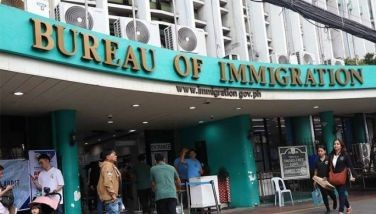Too many traffic obstructions
October 26, 2006 | 12:00am
The City Council, the press release says, is planning an ordinance that prohibits traffic obstructions particularly those in construction sites. This is a long-overdue measure.
I was one of the motorists who got stuck two weeks ago at the corner of Leon Kilat and P. del Rosario streets. Nearby a high-rise building was being constructed and heavy equipment was parked right on the road next to the building. This caused the traffic jam, and it took me about ten minutes before I could get through.
During regular days, especially on peak hours, congestion occurs in this area even without any obstruction, it being a five-way intersection. With the obstacle, it was practically a bumper-to-bumper affair.
Talking of obstructions, there are many of these in our streets. One is the obstruction posed by vehicles parked on no-parking sections. Another are public utilities loading and unloading passengers on no-stopping signs or worse, right on passage lanes. Still another impediments are conveyances which break down at the center of roadways or those which figure in vehicular accidents. Some city streets are narrow and any obstructions happening during rush hours always result in a traffic jam.
In the stretch between Kinasang-an, Pardo, and the Bulacao - Talisay City boundary (and possibly in other streets) there are vehicles stationed for the night or just stopping for some minutes as their drivers or owners transact business with sidewalk stores. Why are these conveyances allowed to arrogate for themselves portions of this critical conduit? many motorists are asking. And why are for hire motorcycles given imprimatur to park at the roadside near the Bulacao bridge? Since no traffic enforcers are in the area, traffic is a nightmare at rush hours in the morning and early evening. City PUJs, by the way, do their u-turn before the bridge's end, and these of course prevent the free flow of carriers in this part of the road. During peak hours the movement of south-bound vehicles is at turtle-pace. Can Citom do something, please?
When a vehicle breaks down at road centers even for a busted tire, it is allowed to stay for some time instead of pushing it out of the way. And when accidents occur involving two or more vehicles, it takes some time before the mess can be disentangled. One reason is that first, Citom personnel are not readily available; second, the question as to who is at fault has to be determined. Perhaps, to solve the first concern a rapid-reaction unit should be organized to rush to accident scenes with dispatch. For the second problem, perhaps our major arteries should be declared no-fault zones to speed up clearance whenever accidents happen.
A traffic obstruction commonly observed is the indiscriminate picking up and dropping of commuters by PUJs. This of course hinders the free flow of vehicles, not to mention the hazard it poses to passengers. One possible solution: Designate strategic areas as stations where commuters board and disembark from PU vehicles. Manned by traffic enforcers or even by tanods, this arrangement will ensure a systematic boarding and dislodging of people in a safer place and will facilitate easy movement of conveyances between stations. With the presence of big city transits now plying jeepney routes, these stations are urgently needed because these trucks are themselves road obstacles as they stop here and there to service the commuting public.
Relative to the traffic situations in the city, the DILG issued years ago a memorandum circular to the effect that local government units have no authority to change the routes LTFRB has granted public utility vehicles. Brought to light at the crest of the current Cebu City-NADSU controversy, this issuance can embolden PUJ drivers to continue plying the Mandaue-Maxilom-Osmeña-avenue route. The result would certainly be congestion in these asteries.
But why must LTFRB lord it over LGUs, especially a highly urbanized LGU like Cebu City, in managing their traffic machinery? If there is one critical problem that needs the attention of the city administration it is the flow of traffic in its streets. For indeed, the quality of traffic management directly affects the quality of life of the people as well as of the economy of the place. Should such important concern be entrusted to armchair moguls in the capital city? What do they care about what's bugging the city's transport system? LTFRB may have the authority to prescribe the routes for utility vehicles, but such authority is not absolute, otherwise, what are local governments for? If LGU empowerment is the idea behind the Local Government Code, then something is wrong with the DILG memorandum circular.
Email: [email protected]
I was one of the motorists who got stuck two weeks ago at the corner of Leon Kilat and P. del Rosario streets. Nearby a high-rise building was being constructed and heavy equipment was parked right on the road next to the building. This caused the traffic jam, and it took me about ten minutes before I could get through.
During regular days, especially on peak hours, congestion occurs in this area even without any obstruction, it being a five-way intersection. With the obstacle, it was practically a bumper-to-bumper affair.
Talking of obstructions, there are many of these in our streets. One is the obstruction posed by vehicles parked on no-parking sections. Another are public utilities loading and unloading passengers on no-stopping signs or worse, right on passage lanes. Still another impediments are conveyances which break down at the center of roadways or those which figure in vehicular accidents. Some city streets are narrow and any obstructions happening during rush hours always result in a traffic jam.
In the stretch between Kinasang-an, Pardo, and the Bulacao - Talisay City boundary (and possibly in other streets) there are vehicles stationed for the night or just stopping for some minutes as their drivers or owners transact business with sidewalk stores. Why are these conveyances allowed to arrogate for themselves portions of this critical conduit? many motorists are asking. And why are for hire motorcycles given imprimatur to park at the roadside near the Bulacao bridge? Since no traffic enforcers are in the area, traffic is a nightmare at rush hours in the morning and early evening. City PUJs, by the way, do their u-turn before the bridge's end, and these of course prevent the free flow of carriers in this part of the road. During peak hours the movement of south-bound vehicles is at turtle-pace. Can Citom do something, please?
When a vehicle breaks down at road centers even for a busted tire, it is allowed to stay for some time instead of pushing it out of the way. And when accidents occur involving two or more vehicles, it takes some time before the mess can be disentangled. One reason is that first, Citom personnel are not readily available; second, the question as to who is at fault has to be determined. Perhaps, to solve the first concern a rapid-reaction unit should be organized to rush to accident scenes with dispatch. For the second problem, perhaps our major arteries should be declared no-fault zones to speed up clearance whenever accidents happen.
A traffic obstruction commonly observed is the indiscriminate picking up and dropping of commuters by PUJs. This of course hinders the free flow of vehicles, not to mention the hazard it poses to passengers. One possible solution: Designate strategic areas as stations where commuters board and disembark from PU vehicles. Manned by traffic enforcers or even by tanods, this arrangement will ensure a systematic boarding and dislodging of people in a safer place and will facilitate easy movement of conveyances between stations. With the presence of big city transits now plying jeepney routes, these stations are urgently needed because these trucks are themselves road obstacles as they stop here and there to service the commuting public.
Relative to the traffic situations in the city, the DILG issued years ago a memorandum circular to the effect that local government units have no authority to change the routes LTFRB has granted public utility vehicles. Brought to light at the crest of the current Cebu City-NADSU controversy, this issuance can embolden PUJ drivers to continue plying the Mandaue-Maxilom-Osmeña-avenue route. The result would certainly be congestion in these asteries.
But why must LTFRB lord it over LGUs, especially a highly urbanized LGU like Cebu City, in managing their traffic machinery? If there is one critical problem that needs the attention of the city administration it is the flow of traffic in its streets. For indeed, the quality of traffic management directly affects the quality of life of the people as well as of the economy of the place. Should such important concern be entrusted to armchair moguls in the capital city? What do they care about what's bugging the city's transport system? LTFRB may have the authority to prescribe the routes for utility vehicles, but such authority is not absolute, otherwise, what are local governments for? If LGU empowerment is the idea behind the Local Government Code, then something is wrong with the DILG memorandum circular.
Email: [email protected]
BrandSpace Articles
<
>
- Latest
- Trending
Trending
Latest
Trending

By BABE’S EYE VIEW FROM WASHINGTON D.C. | By Ambassador B. Romualdez | 15 hours ago

By IMMIGRATION CORNER | By Michael J. Gurfinkel | 15 hours ago
Latest
Recommended
























